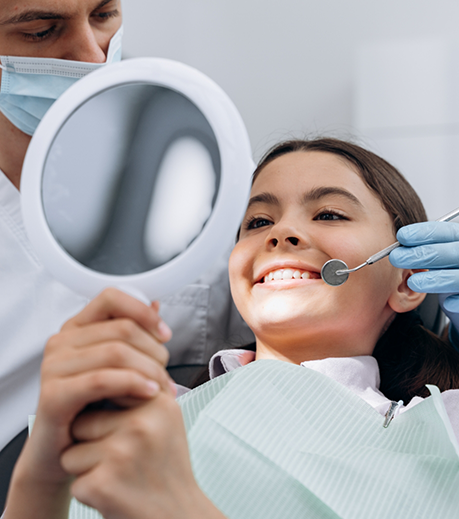Phase One Orthodontics Cumming
An Early Start to a Straighter Smile

At Serenity Orthodontics, our team of experts is here to help your child’s smile grow healthy and strong. By the age of 7, it is recommended that you bring them in for a regular orthodontic evaluation. It is at this time we can review their oral structure and determine if there are problems that exist that might result in the need for braces later on. If so, we can offer Phase One Orthodontics as a solution to help correct alignment problems before their adult teeth begin to erupt. This process is also designed to help eliminate non-nutritive behaviors that can lead to orthodontic problems later on, such as thumb-sucking or tongue-thrusting. To learn more about this unique system and how it can help your little one, contact us today to schedule a free consultation for Phase One Orthodontics in Cumming.
Why Choose Serenity Orthodontics for Phase One Orthodontics?
- Three Trusted and Certified Female Orthodontists
- Free Consultations Available
- Convenient, 0% In-House Financing
Does My Child Need Phase One Orthodontics?

How do you know if your child needs Phase One Orthodontics? Unless you can easily recognize the signs, you may not know it until you schedule a consultation with a trusted orthodontist. While this is necessary for your child to undergo treatment, Dr. Podray-Donovan, Dr. Pelt, and Dr. Lewis want you to feel more informed about your child’s oral health and development. If you notice any of the following signs, there is a good chance your little one will benefit from Phase One Orthodontics:
- Their teeth are protruding
- They have difficulty breathing or speaking
- They suck their thumb or finger
- Their teeth appear gapped, crooked, or crowded
- Their teeth do not appear to come together correctly
- Their baby teeth continue to obstruct their adult teeth
- Their jaw appears disproportionate to the rest of their head
The important component to keep in mind is that your child’s smile and facial structure are continuing to develop. As a result, even if they do not show any of the above-mentioned signs, they could benefit from Phase One Orthodontics. Only our orthodontists can determine if it is necessary, which is why it is best to schedule a consultation early on to ensure positive and healthy results in the future.
What Happens After Phase One Orthodontics?

If your child completes Phase One Orthodontics, you can rest easy knowing they won’t require braces later on, right? While this is a nice theory, it’s not always the case. In most situations, our team will give your child’s oral structure a chance to rest for about a year before starting Phase Two Orthodontics. During this time, you can expect their smile to continue to develop. When the time is right, we will re-evaluate. If it proves that Phase One was enough to address your child’s individual needs, there may be no reason to move forward to Phase Two. However, if your child needs additional treatment, Phase Two will help correct their permanent teeth and give them a healthier, straighter smile.
What You Should Remember About Phase One Orthodontics

The reason it is recommended that your child visit the orthodontist by the time they reach the age of 7 is that it is much easier to realign and straighten developing smiles. Because a child’s teeth and jaw are not permanently affixed into place, their treatment may not take as long as an adult who needs braces.
By starting Phase One Orthodontics early on, you can start your child on a path to a healthier smile and potentially avoid more complex and timely orthodontic treatment later on. Seeing a qualified and trusted orthodontist to evaluate and monitor your child’s oral development will allow them to customize their treatment in a way that ensures beautiful results.
Phase One Orthodontics FAQs
Is Phase One Orthodontics Painful?
Our team will make sure your little one is as comfortable as possible throughout the process, so your child shouldn’t experience pain when getting their oral appliance. Of course, it’s natural for them to feel some slight discomfort after having their appliance placed. Fortunately, these symptoms should be short-lived and easily alleviated with over-the-counter/prescribed pain medications as well as cold compresses. Your child’s mouth should also adjust quickly to the process. Remember that without Phase One Orthodontics, they can potentially experience greater discomfort later on, such as chewing complications due to a bite misalignment.
What Appliances Are Used in Phase One Orthodontics?
Phase One Orthodontics isn’t as complicated as other treatments, so you can expect your child to use simpler appliances. For instance, a palate expander can be used for children with overcrowded teeth, as the device helps widen the upper jaw. Baby teeth that are lost prematurely may need a space maintainer to prevent dental shifting so the permanent ones can grow out properly. Children with more severe orthodontic problems might require limited braces, which only target specific teeth as their jaws (and other teeth) are still maturing. Our team will review your little one’s specific treatment plan and determine the proper appliance(s) to ensure a more comfortable and healthier smile in the future.
When Does Phase One Orthodontics Take Place?
Phase One Orthodontics, also known as “interceptive orthodontics,” is typically provided for children ages 6 through 9. This is the dentition phase—when baby teeth begin to fall out on their own. At this time, the dentist can begin detecting any issue with jawbone growth and tooth development, which is easiest to treat in younger patients. Additionally, children begin to have their first molars erupt around age 7, which can help us predict how their bite will form over time.
Does Phase One Orthodontics Affect Diet & Nutrition?
Your little one’s meals may be affected depending on the kind of appliance they receive for Phase One Orthodontics. Those with palate expanders or a set of limited braces might need to refrain from eating foods that are tougher to chew, like raw veggies, nuts, and steak. They’ll have to stick to a soft food diet to avoid damaging their appliances or disrupting their orthodontic process. Instead, make sure your little one eats food like bread, soft meats, dairy products, and cooked veggies. That said, if your child has removable appliances, then they won’t have to worry as much about dietary restrictions!
How Long Does Phase One Orthodontic Treatment last?
On average, Phase One Orthodontics takes between 9 and 12 months. Of course, the length of your child’s treatment plan may be shorter or longer – it depends largely on the severity of their case. Other factors play a role, including how well your child follows the treatment guidelines.
Is it Okay for a Child to Play Sports While Wearing Braces?
The good news is that orthodontic treatment rarely interferes with sports and other physical activities. There’s just one rule: your child must wear a mouthguard. This dental device may be small, but it plays a big role in preventing orthodontic emergencies, like a loose bracket or broken wire. If your child doesn’t have one (or they are using a one-size-fits-all one from a sporting goods store), then schedule an appointment with us so we can have a custom one made.
Note: If your child does damage their braces while on the stage, field, or mat, then call us ASAP.
What Happens After Phase One Orthodontics?
That depends! If your child’s needs were fully addressed with Phase One Orthodontics, then Phase Two may not be necessary. Conversely, if the look, health, and function of their smile would benefit from later phases, then we will likely wait a year or so before moving forward. Fortunately, when the time does come, their treatment plan will be a bit shorter since the position of their teeth and the alignment of their bite have already benefited from Phase One!
What Changes Should My Child Make While Wearing Braces?
Although braces today are significantly more comfortable, efficient, and hassle-free than they were decades prior, there are still some changes your child needs to make to prevent an orthodontic emergency. That starts with avoiding crunchy, hard, and sticky foods, like caramel candies, tortilla chips, whole apples, and thin pizza crust. It’s also of the utmost importance that they commit to a solid at-home oral hygiene regimen, including brushing twice a day and flossing each evening.
Some changes can make your child’s orthodontic treatment more comfortable, like sticking to soft foods immediately following the adjustment appointments and using dental wax to prevent soft tissue irritation.
How Do I Know My Child Needs Phase One Orthodontics?
If your child has an overbite, their jaw seems off-centered, or their teeth are crooked, then there’s a chance that they need Phase One Orthodontic treatment. Of course, the only way to know for sure is by bringing them in for a visit with our team at Serenity Orthodontics. At this appointment, one of our compassionate, friendly, and highly trained orthodontists will conduct a thorough screening, review their findings, and share their recommendations on the next best steps.

